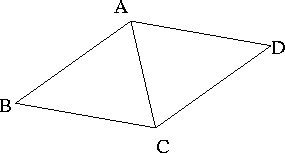-
What do the lists
(+ 3 4 (* (+ a 2) (- x 3) z) (* 3 x y))
and
(+ -2 (- 2) (* X (+ Y 3.3)))
represent in normal mathematical (infix) notation? - How are the expressions xyz+3(u+v) and (xy-xz)(xy+z + 3u) to be represented in Lisp notation?
((A B C D) (B A C) (C A B D) (D A C)) is used to represent the following graph:

The same graph would be represented in edge-based form by the list
((A B) (A C) (A D) (B C) (C D)).
-
Draw the graph represented by
the list
((X Y E F) (Z Y E F) (Y X Z) (E X Z) (F X Z)) - what is the edge based representation for this graph?
- (A . NIL)
- (A . B)
- ((A . NIL) . B)
- ((A . ( B . ( C . NIL))) . NIL)
- ((A . B) . ((C . D) . NIL))
- (cons 'a nil)
- (cons 'a 'b)
- (cons 'a (cons 'b (cons 'c (cons 'd nil))))
- (cons (cons 'a nil) (cons 'b nil))
- (car (cons (cons 'a 'b) (cons 'c 'd)))
- (cdr (cons (cons 'a 'b) (cons 'c 'd)))
- (car (cons (cons 'a 'b) (car (cons 'c 'd))))
- (( a . b) . X)
- (( X . b) . c)
- ( a . (( X . b) . c))
- (a . (b . c))
- (a b c)
- (a b c (d . (e . f)))
- (a (b) (c . d) (( e . f) . g))
Draw each of the following in box and pointer notation:
- X, Y, and Z
- (cons X (cons 1 (cons X nil)))
- (cons X (cons (cons 'a 'b) X))
- (cons X (car Z))
- (equal X (car Z)
- (equal X (cons 'a 'b))
- (eq X (car Z))
- (eq X (cons 'a 'b))
- (atom X)
- (atom (car X))
- (null Y)
- (null (cdr Y))
- (atom (car (car (car (cons Z X)))))